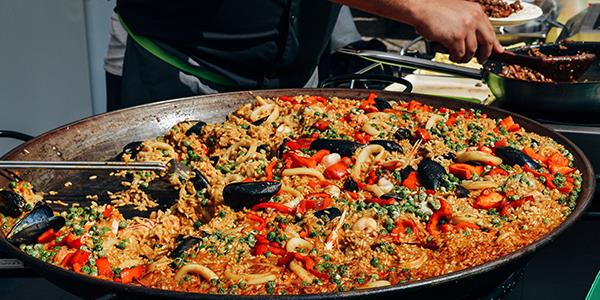
What is paella?
The traditional Spanish dish Paella is a filling rice-based meal usually made with pieces of fish or meat and lots of spices in a big pan over an open flame. Though you can now find paella dishes in restaurants across Europe, it is assumed that paella origin dates from the Moorish occupation. So why is paella popular in Spain?
Paella Valenciana history – where does paella come from?
With the introduction of better irrigation during the 10th century, it’s likely that rice production would have boomed throughout the country. The Valencian region, where is paella from, in the south east of Spain, would consequently have produced rice and fish dishes at large family occasions – making use of the warm climate to cook out in the open. It was also very likely a staple dish for religious feasts too: not being acceptable to eat meat during lent, by the 15th century, cooks had combined rice with vegetables and dry fish to create a meal that was appropriate for the occasion.
The custom took off along Spain's eastern coast and the term is thought to derive from the Latin word patella meaning pan or container. By the 19th century Valencians were using 'paelleras', (pans used to cook rice) out in the open during the sorts of gatherings and countryside outings that would have increased along with the standards of living at this time. Originally the main ingredients included meet and beans.
Paella became more and more popular and it was in the 19th century that the word 'paella' was first used in a newspaper to refer to the recipe rather than the pan. Throughout the following century, the popularity of making paella started to spread outside the country and reach other areas in Europe. Valencia’s position on the coast meant people had access to a lot of good seafood to add to their dishes and though the original paella recipe used rice, meat and beans along with saffron and paprika; the most popular form nowadays is seafood paella.

Along the east and south coasts of Spain, you will find it difficult not to encounter a paella restaurant. Right in the south of the country, looking out over the Mediterranean, Almería has a very ecologically rich coast and the villages around there were dedicated to fishing. The market square is just off Paseo de Almería, near the coast and the large covered market sells all sorts of wonders and fresh produce. There's a great choice of restaurants there as well!
It’s such a big part of Spanish culture that you should always try to incorporate a paella into your trip, and if you’re staying at El Pueblito de Alfiax you’ll have the opportunity to see a traditional paella demonstration from a Spanish chef. If you just can't wait that long, we've included a quick paella recipe to try at home below:
Paella Recipe
- 1 tbsp olive oil
- 1 chopped onion
- 1 tsp smoked paprika
- 1 tsp dried thyme
- 300g paella rice
- 400g chopped tomatoes
- 900ml chicken stock
- 400g seafood mix
- 1 lemon (1/2 juiced, 1/2 wedges)
- handful of chopped parsley
Heat the olive oil in a large frying pan or wok, add the onion and soften for approximately five minutes. Add the smoked paprika, thyme and paella rice, stir for one minute then add chopped tomatoes and chicken stock. Season and cook for around 15 minues, stirring occasionall, until rice is lmost cooked and still has some liquid. Stir in the seafood mix and cover to simmer for 5 minutes. Squeeze over lemon juice and paslet and then serve with lemon wedges.

Frequently asked questions
What is the difference bwteen Paella and Paella Valenciana?
'Paella' is the general name of the dish, while Paella Valenciana is the original version that was made, as the name suggested, in Valencia. As well as the usual rice, it iincludes chicken, pork and sometimes rabbit. Besides this, there are several other versions of Paella, including Paella Marisco and Paella Marinera (which include seafood) and Paella Vegetariana, which is vegetarian version.
Where is paella most popular?
Valencia is still credited as having the best and most authentic paella, and you'll find it readily available throughout the city. And it's not just tourists that eat this iconic dish – it's still a popular choice with locals, who eat is socially from large communal pans..
What is the crispy rice at the bottom of the paella?
Those crispy pieces at the bottom of the paella are called the socarrat, formed where the rice becomes caramelizard and toasted. A good socarat is the sign of an excellent paella, and the reason traditional paella is served in the pan it was cooked in.
Interested in staying in Spain, but not sure about timeshare? Our property investments offer unique and amazing holiday properties to stay throughout Europe. Complete the form below today to find out more.

